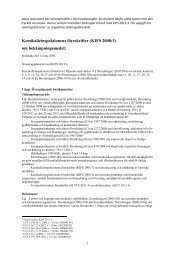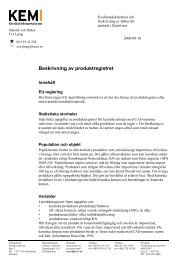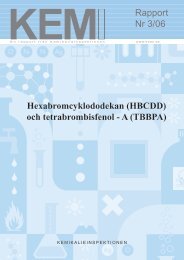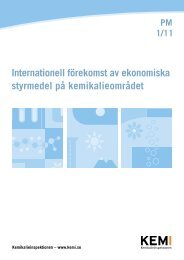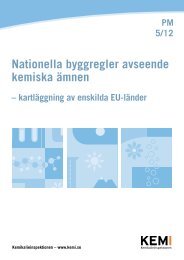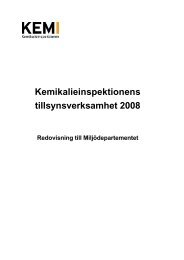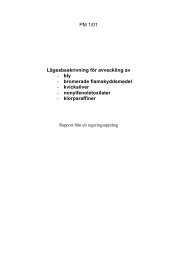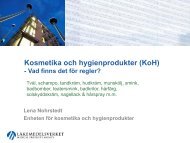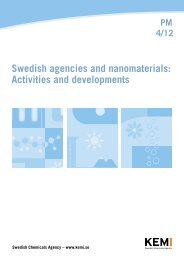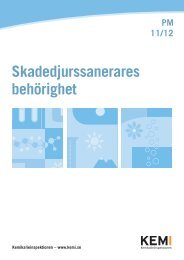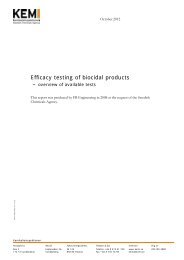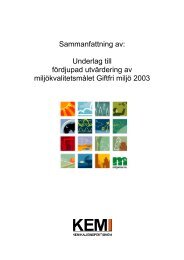Kemikalier och klimat - Kemikalieinspektionen
Kemikalier och klimat - Kemikalieinspektionen
Kemikalier och klimat - Kemikalieinspektionen
You also want an ePaper? Increase the reach of your titles
YUMPU automatically turns print PDFs into web optimized ePapers that Google loves.
Manufacturer take-back provides an important incentive for the reduction of<br />
toxics in manufacturing and encourages the design of products that are easier and<br />
safer to recycle. It also gives companies an incentive to recycle decommissioned<br />
and defective solar PV panels into new solar panels.<br />
The European Photovoltaic Industry Association (through its PV Cycle initiative)<br />
and the German Solar Business Association have endorsed full lifecycle<br />
accountability and product take-back for the solar PV sector. Germany accounts<br />
for both the largest solar PV market and the largest share of production.<br />
A few companies are already establishing take-back and recycling programs. An<br />
Arizona-based firm has adopted the world’s first pre-funded take-back policy for<br />
its cadmium telluride (CdTe) solar panels. A German company has established a<br />
pilot-scale recycling facility that uses defective and used crystalline silicon (c-Si)<br />
solar panels to make new panels. Further research on recycling is being conducted<br />
on solar PV panels made from other materials and using other recovery processes.<br />
C. Ensure Proper Testing of New and Emerging Materials and Processes<br />
All new chemicals and materials developed for use in the solar PV industry should<br />
be properly tested. The following general guidelines should be applied:<br />
• Policies should incorporate a precautionary approach, requiring that those<br />
who advocate the use of new chemicals or processes prove their safety (rather<br />
than requiring communities or workers to prove their dangers).<br />
• Apply green chemistry principles as a screen for PV cell technology<br />
based on organic materials and inorganic crystals and for other emerging<br />
solar cell technologies before a prototype is available for market.<br />
In addition, more extensive testing should be conducted on new chemicals or new<br />
materials being introduced and on the chemicals already in use. The latter<br />
category includes cadmium telluride (CdTe); cadmium telluride quantum dots;<br />
copper indium selenide (CIS) crystals; gallium arsenide (GaAs); and gallium.<br />
D. Expand Recycling Technology and Design Products for Easy Recycling<br />
To meet the challenges of solar PV recycling, manufacturers should be<br />
encouraged to:<br />
• Invest in recycling infrastructure. Communicate with existing glass,<br />
electronics, and battery recycling companies to build the infrastructure and<br />
capacity to recycle solar PV.<br />
• Design for recycling. Design all solar products for ease of recycling by<br />
reducing the use of toxic materials and designing products to be easily<br />
disassembled.<br />
• Use silicon recovered from consumer electronics products. Because solar<br />
grade silicon does not have to be as pure as the c-Si used in computer micr<strong>och</strong>ips,<br />
the reuse of silicon recovered from consumer electronics (like televisions,<br />
computers, and cell phones) should be explored.<br />
• Develop recycling processes for all rare metals. Develop plans to recover all<br />
rare metals such as tellurium (CdTe panels) and indium (CIS panels).<br />
44



